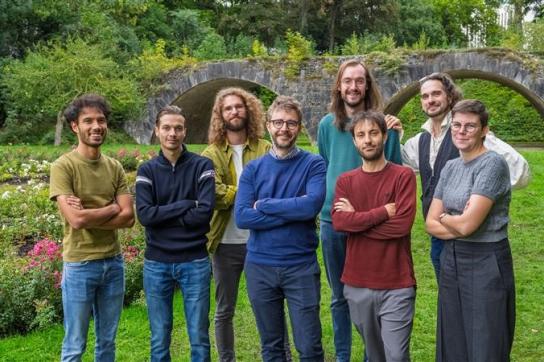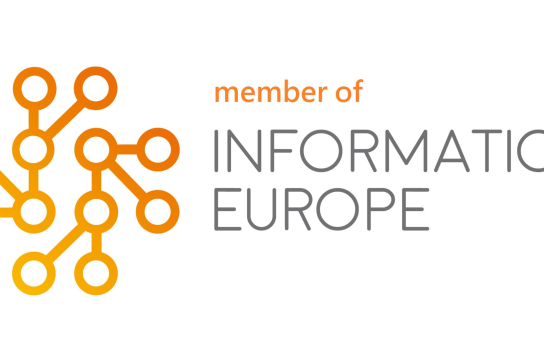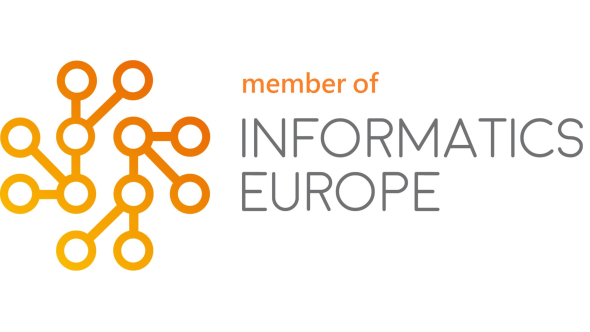Informatics at the service of collective well-being and personal development.
The Faculty of Informatics has a vision of a world in which the intensive and growing use of informatics is oriented towards collective well-being and personal development. Its mission is to contribute to this orientation through education, scientific research and service to society.
The studies
When you choose to study computer science, you're guaranteed immediate access to an exciting, multi-faceted career. Through a comprehensive range of courses - bachelor's, master's, specialization master's and doctorate - the Faculty of Computer Science offers you quality training based on scientific rigor and critical thinking, while emphasizing interdisciplinarity and societal responsibility.

Research
The mission of the Faculty of Computer Science is to ensure cutting-edge scientific research, open to the creation and integration of knowledge that feeds teaching, technological innovation and societal debate.

Service to society
The Faculty of Computer Science contributes to the development of our social, economic, technological and political environment by disseminating knowledge and providing advice at regional, national and international levels. Through the synergy between researchers and industry, and by making knowledge and know-how available, it participates in numerous missions of service to society.

International
The Faculty of Computer Science's international outlook is fundamental to the development of its teaching and research activities.

Organization
The Faculty of Computer Science has organized itself to manage its missions in the best possible way. It has around a hundred members at the service of teaching, research and service to society.
A word from the Dean
IT is a key to understanding, progress and responsibility in the face of the challenges and issues facing our society.


Spotlight
News

27 new research projects funded by the FNRS
27 new research projects funded by the FNRS
The F.R.S.-FNRS has just published the results of its various 2025 calls. These include the "Credits & Projects" and "WelCHANGE" calls, as well as the "FRIA" (Fonds pour la formation à la Recherche dans l'Industrie et dans l'Agriculture) and "FRESH" (Fonds pour la Recherche en Sciences Humaines) calls to support doctoral theses. Results for UNamur? 27 selected projects testifying to the quality and richness of research at UNamur.

The "Credits & Projects" call resulted in 12 grants for ambitious new projects. These include two "equipment" grants, eight "research credits (CDR)" grants and two "research projects (PDR)" grants, including one in collaboration with ULB. The FRIA doctoral research support call will fund eleven doctoral scholarships, and the FRESH call, three.
Two prestigious Mandat d'Impulsion Scientifique (MIS) have also been secured. This 3-year funding supports young permanent researchers wishing to develop an original and innovative research program while acquiring scientific autonomy within their department.
Let's also mention the two projects funded under the "WelCHANGE" call for proposals; an instrument for funding research projects with potential societal impacts, led by a main promoter from the Humanities and Social Sciences.
So, let's also mention the two projects funded under the "WelCHANGE" call for proposals.Results in detail
Appel Equipment
- Xavier De Bolle, Institut Narilis, Co-sponsor in collaboration with UCLouvain
- Luca Fusaro, Institut NISM
Call for Research Credits (CDR)
- Marc Hennequart, Institut NARILIS
- Nicolas Gillet, Institut NARILIS
- Jean-Yves Matroule, Institut NARILIS
- Patricia Renard, Institut NARILIS
- Francesco Renzi, Institut NARILIS
- Stéphane Vincent, Institut NISM
- Laurence Meurant, Institut NaLTT
- Emma-Louise Silva, Institut NaLTT
Call for Research Projects (PDR)
- Jérémy Dodeigne, Institut Transitions, Co-promoter in collaboration with ULB
- Luc Henrard, Institut NISM; Co-promoter: Yoann Olivier, Institut NISM
Fonds pour la formation à la Recherche dans l'Industrie et dans l'Agriculture (FRIA)
- Emma Bongiovanni - Promoter: Catherine Michaux, Institut NISM
- Simon Chabot - Promoter: Carine Michiels, Institut Narilis; Co-promoter: Anne-Catherine Heuskin, Institut Narilis
- Lee Denis - Promoter: Muriel Lepère, Institut ILEE
- Maé Desclez - Promoter: Johan Yans, Institut ILEE; Co-promoter: Hamed Pourkhorsandi (University of Toulouse)
- Pierre Lombard - Promoter: Benoît Muylkens, Institut Narilis; Co-promoter: Damien Coupeau, Institut Narilis
- Amandine Pecquet - Promoter: Nicolas Gillet, Institut Narilis; Co-promoter: Damien Coupeau, Institut Narilis
- Kilian Petit - Promoter: Henri-François Renard, Institut Narilis; Co-promoter: Xavier De Bolle, Institut Narilis
- Simon Rouxhet - Promoter: Catherine Michaux, Institut NISM; Co-promoter: Nicolas Gillet, Institut Narilis
- William Soulié - Promoter: Yoann Olivier, Institut NISM
- Elisabeth Wanlin - Promoter: Xavier De Bolle, Institut Narilis
- Laura Willam - Promoter: Frédérik De Laender, Institut ILEE
Fonds pour la Recherche en Sciences Humaines (FRESH)
- Louis Droussin - Promoter: Arthur Borriello, Institut Transitions; Co-promoter: Vincent Jacquet, Institut Transitions
- Nicolas Larrea Avila - Promoter: Guilhem Cassan, Institut DeFIPP
- Victor Sluyters - Promoter: Wafa Hammedi, Institut NADI
Mandat d'Impulsion Scientifique (MIS)
- Charlotte Beaudart, Institut Narilis
- Eli Thoré Institut ILEE
Appel WelCHANGE
- Nathalie Burnay Institut Transitions, in collaboration with UCLouvain
- Catherine Guirkinger Institut DeFIPP
Congratulations to one and all!

SPiN: a new research center for a new way of thinking about science
SPiN: a new research center for a new way of thinking about science
At a time when misinformation, post-truths and conspiracies are undermining confidence in science, UNamur welcomes SPiN (Science & Philosophy in Namur), a new interdisciplinary research center that questions the place of science in society. Founded last September by Olivier Sartenaer, Professor of Philosophy of Science at UNamur, SPiN brings together philosophers and scientists around a common vision: to develop a critical and accessible reflection on science in all its diversity.
.
Olivier Sartenaer's team: Doan Vu Duc, Maxime Hilbert, Charly Mobers, Olivier Sartenaer, Louis Halflants, Andrea Roselli, Gauvain Leconte-Chevillard, Eve-Aline Dubois.
While UNamur is distinguished by the presence of a Philosophy of Science department within its Faculty of Science, until now there has been no research center specifically dedicated to the epistemological, ethical, political and metaphysical challenges of science. SPiN fills this gap.

"Several contingent factors enabled the creation of SPiN: the absence of a research structure specifically dedicated to these themes and the almost simultaneous arrival of four young philosophers of science. It's a bit like an alignment of the planets", explains Olivier Sartenaer.
At his side are Juliette Ferry-Danini (Faculty of Computer Science), Thibaut De Meyer (Faculty of Philosophy and Letters) and Gaëlle Pontarotti (Faculty of Science), who form the core of SPiN.
Responding to strong societal demand
SPiN is part of a research dynamic committed to the heart of contemporary debates.

There is a real need for citizens to be enlightened on these issues. It was important for us that a research structure reflect this growing societal demand and host research on these themes.
SPiN researchers explore a wide range of themes, against a backdrop of questioning our relationship to scientific knowledge. These include:
- the relationship between science and pseudoscience;
- reductionism in science;
- genetic determinism and heredity;
- medical ethics and public health (vaccinations, pandemics);
- ethology,
- perspectivism.
This research is carried out by an interdisciplinary team of teacher-researchers, doctoral students and post-docs from the various faculties of UNamur.
An academic meeting place...but also a civic meeting place
SPiN organizes weekly seminars devoted to current research in philosophy of science, as well as seminars linked to more specific themes: health, life sciences, cosmology and theories of emergence and reductionism in the natural sciences.
But SPiN is not limited to the academic sphere: the center intends to take these issues outside the university walls, through events and activities accessible to all. An inaugural event is already planned for next spring on a topical theme: mistrust in science. More info to come!
Find out more about the SPiN research center

Digital literacy through fiction: NaDI's interdisciplinary initiative
Digital literacy through fiction: NaDI's interdisciplinary initiative
The Namur Digital Institute (NaDI) is launching a series of original events: "Les Séances du Numérique". Films followed by debates with experts to understand digital challenges and stimulate collective thinking. A project spearheaded by Anthony Simonofski, Anne-Sophie Collard, Benoît Vanderose and Fanny Barnabé.

The Digital Sessions are an initiative launched by the NaDI, the digital research institute at UNamur. The latter brings together researchers from the Faculties of law, informatics and EMCP.
To stimulate interdisciplinary collaboration, NaDI has launched a call for projects. One of the selected projects? Les Séances du Numérique, an original format in which fiction becomes the starting point for debate. Each meeting begins with a film screening, followed by an interdisciplinary conference on a digital-related social issue.
An outstanding first Séance du Numérique
To inaugurate the cycle, the team chose to screen The Social Network last May. The film traces the creation of Facebook by Mark Zuckerberg, and the debate focused on the moderation of social networks, a hot topic since the election of Donald Trump. Two experts led the discussion: Julien Albert, expert at the PReCISE center, and Jérémy Grossman, expert at CRIDS.

Educating through fiction
The ambition of these sessions is simple: to educate about digital issues through fiction, and to confront a variety of viewpoints.
This format extends the experience of the podcast Pop-Code already hosted by Anthony Simonofski and Benoît Vanderose, but with an added dimension: interdisciplinarity and direct exchange with the audience. After the film, everyone can question the experts and enrich the reflection.
What next?
Digital technology will be at the heart of future screenings, with a dynamic that is both collaborative and rooted in current affairs:
- Fostering collaboration between several NaDI centers to bring disciplines into dialogue (as was the case at the first session with CRIDS and PReCISE).
- Bouncing off themes linked to current events to guarantee the relevance of exchanges.
Four sessions will be offered per year, open to all, with one priority: reaching out to citizens. The films are there to give the event a cultural and scientific outreach.
Eventually, the team would like to diversify its formats: screenings in cinemas like Caméo, broadcasting series, even playconferences where we play a video game during the debate. The idea: to use fiction in all its forms to kick-start discussion.
The team behind the project
- Fanny Barnabé, lecturer at CRIDS / NaDI
- Anne-Sophie Collard, professor at the EMCP Faculty
- Anthony Simonofski, professor at the EMCP Faculty
- Benoît Vanderose, professor at the Computer Science Faculty
In collaboration with the Knowledge Confluence and the Administration de la communication
Next session: November 4 - "Does AI have a conscience?"
Projection of the film Ex Machina followed by a discussion with Isabelle Linden and Benoît Frenay.
Think, think: is the human being still unique?
Behind the AI revolution, a question arises: does AI have a conscience? For this second screening-debate of Séances du Numérique, we invite you to dive into the film Ex_machina, a troubling face-off between creation and creator, between human and machine, between future and humanity.
Program:
- 5pm: Welcome & film presentation
- 5:15pm: Screening of the film Ex machina
- 7:05pm: Debate "Does AI have a conscience? " (with Isabelle Linden & Benoît Frenay)
- 19h45: end
Two experts will take part in the debate:
- Benoît Frenay, who will shed light on the learning logics of today's artificial intelligences and the limits of their "autonomy". Can we really speak of intelligence without consciousness? How far can imitation go?
- Isabelle Linden, who will question the very foundations of what we call "thinking" in a computer logic. Can we create a conscious machine? Or are we merely facing mirrors of our own desires?


UNamur's Faculty of Informatics joins the Informatics Europe network
UNamur's Faculty of Informatics joins the Informatics Europe network
This is great recognition for the excellence of the research carried out at the University of Namur: the Faculty of Informatics has been asked to join the prestigious Informatics Europe network, which brings together the most dynamic departments and faculties of Informatics across Europe.

The Informatics Europe network federates nearly 200 institutions in more than 30 European countries and brings together Europe's academic and research computing community, connecting more than 50,000 researchers in the fields of computing, information technology and digital sciences.

To be invited to join this network is both a wonderful recognition of the expertise and quality of our research and teaching commitment at UNamur, and a fantastic opportunity to roll out new projects in both research and teaching
.

The network's stated aim is to have greater influence with European political bodies on issues concerning IT. The expertise of UNamur's Faculty of Informatics can contribute to this goal. The network also has working groups in which we can play an active role, such as the Diversity and Inclusion group. The Faculty has set up several initiatives in recent years and is active in research on this subject. For example, Professor Vincent Englebert's team is working on digital accessibility issues for the elderly. Our colleague Julie Henry is already collaborating with this network on issues of gender diversity in computer science studies.
.
By joining this network, the Faculty of Informatics opens the door to:
- European collaborations on cutting-edge research projects;
- Exchanges of good teaching practice with partner institutions;
- Greater visibility on the international academic scene.
Meetings between network members will take the form of workshops organized by theme, as well as an annual general meeting. Each year, Informatics Europe also offers a summer school for IT students.
Read more
Informatics Europe network: https://www.informatics-europe.org
Institutional or faculty agreements established by UNamur with foreign partners:https://www.unamur.be/fr/international/reseaux-partenariats
The Faculty of Informatics: https://www.unamur.be/fr/info

27 new research projects funded by the FNRS
27 new research projects funded by the FNRS
The F.R.S.-FNRS has just published the results of its various 2025 calls. These include the "Credits & Projects" and "WelCHANGE" calls, as well as the "FRIA" (Fonds pour la formation à la Recherche dans l'Industrie et dans l'Agriculture) and "FRESH" (Fonds pour la Recherche en Sciences Humaines) calls to support doctoral theses. Results for UNamur? 27 selected projects testifying to the quality and richness of research at UNamur.

The "Credits & Projects" call resulted in 12 grants for ambitious new projects. These include two "equipment" grants, eight "research credits (CDR)" grants and two "research projects (PDR)" grants, including one in collaboration with ULB. The FRIA doctoral research support call will fund eleven doctoral scholarships, and the FRESH call, three.
Two prestigious Mandat d'Impulsion Scientifique (MIS) have also been secured. This 3-year funding supports young permanent researchers wishing to develop an original and innovative research program while acquiring scientific autonomy within their department.
Let's also mention the two projects funded under the "WelCHANGE" call for proposals; an instrument for funding research projects with potential societal impacts, led by a main promoter from the Humanities and Social Sciences.
So, let's also mention the two projects funded under the "WelCHANGE" call for proposals.Results in detail
Appel Equipment
- Xavier De Bolle, Institut Narilis, Co-sponsor in collaboration with UCLouvain
- Luca Fusaro, Institut NISM
Call for Research Credits (CDR)
- Marc Hennequart, Institut NARILIS
- Nicolas Gillet, Institut NARILIS
- Jean-Yves Matroule, Institut NARILIS
- Patricia Renard, Institut NARILIS
- Francesco Renzi, Institut NARILIS
- Stéphane Vincent, Institut NISM
- Laurence Meurant, Institut NaLTT
- Emma-Louise Silva, Institut NaLTT
Call for Research Projects (PDR)
- Jérémy Dodeigne, Institut Transitions, Co-promoter in collaboration with ULB
- Luc Henrard, Institut NISM; Co-promoter: Yoann Olivier, Institut NISM
Fonds pour la formation à la Recherche dans l'Industrie et dans l'Agriculture (FRIA)
- Emma Bongiovanni - Promoter: Catherine Michaux, Institut NISM
- Simon Chabot - Promoter: Carine Michiels, Institut Narilis; Co-promoter: Anne-Catherine Heuskin, Institut Narilis
- Lee Denis - Promoter: Muriel Lepère, Institut ILEE
- Maé Desclez - Promoter: Johan Yans, Institut ILEE; Co-promoter: Hamed Pourkhorsandi (University of Toulouse)
- Pierre Lombard - Promoter: Benoît Muylkens, Institut Narilis; Co-promoter: Damien Coupeau, Institut Narilis
- Amandine Pecquet - Promoter: Nicolas Gillet, Institut Narilis; Co-promoter: Damien Coupeau, Institut Narilis
- Kilian Petit - Promoter: Henri-François Renard, Institut Narilis; Co-promoter: Xavier De Bolle, Institut Narilis
- Simon Rouxhet - Promoter: Catherine Michaux, Institut NISM; Co-promoter: Nicolas Gillet, Institut Narilis
- William Soulié - Promoter: Yoann Olivier, Institut NISM
- Elisabeth Wanlin - Promoter: Xavier De Bolle, Institut Narilis
- Laura Willam - Promoter: Frédérik De Laender, Institut ILEE
Fonds pour la Recherche en Sciences Humaines (FRESH)
- Louis Droussin - Promoter: Arthur Borriello, Institut Transitions; Co-promoter: Vincent Jacquet, Institut Transitions
- Nicolas Larrea Avila - Promoter: Guilhem Cassan, Institut DeFIPP
- Victor Sluyters - Promoter: Wafa Hammedi, Institut NADI
Mandat d'Impulsion Scientifique (MIS)
- Charlotte Beaudart, Institut Narilis
- Eli Thoré Institut ILEE
Appel WelCHANGE
- Nathalie Burnay Institut Transitions, in collaboration with UCLouvain
- Catherine Guirkinger Institut DeFIPP
Congratulations to one and all!

SPiN: a new research center for a new way of thinking about science
SPiN: a new research center for a new way of thinking about science
At a time when misinformation, post-truths and conspiracies are undermining confidence in science, UNamur welcomes SPiN (Science & Philosophy in Namur), a new interdisciplinary research center that questions the place of science in society. Founded last September by Olivier Sartenaer, Professor of Philosophy of Science at UNamur, SPiN brings together philosophers and scientists around a common vision: to develop a critical and accessible reflection on science in all its diversity.
.
Olivier Sartenaer's team: Doan Vu Duc, Maxime Hilbert, Charly Mobers, Olivier Sartenaer, Louis Halflants, Andrea Roselli, Gauvain Leconte-Chevillard, Eve-Aline Dubois.
While UNamur is distinguished by the presence of a Philosophy of Science department within its Faculty of Science, until now there has been no research center specifically dedicated to the epistemological, ethical, political and metaphysical challenges of science. SPiN fills this gap.

"Several contingent factors enabled the creation of SPiN: the absence of a research structure specifically dedicated to these themes and the almost simultaneous arrival of four young philosophers of science. It's a bit like an alignment of the planets", explains Olivier Sartenaer.
At his side are Juliette Ferry-Danini (Faculty of Computer Science), Thibaut De Meyer (Faculty of Philosophy and Letters) and Gaëlle Pontarotti (Faculty of Science), who form the core of SPiN.
Responding to strong societal demand
SPiN is part of a research dynamic committed to the heart of contemporary debates.

There is a real need for citizens to be enlightened on these issues. It was important for us that a research structure reflect this growing societal demand and host research on these themes.
SPiN researchers explore a wide range of themes, against a backdrop of questioning our relationship to scientific knowledge. These include:
- the relationship between science and pseudoscience;
- reductionism in science;
- genetic determinism and heredity;
- medical ethics and public health (vaccinations, pandemics);
- ethology,
- perspectivism.
This research is carried out by an interdisciplinary team of teacher-researchers, doctoral students and post-docs from the various faculties of UNamur.
An academic meeting place...but also a civic meeting place
SPiN organizes weekly seminars devoted to current research in philosophy of science, as well as seminars linked to more specific themes: health, life sciences, cosmology and theories of emergence and reductionism in the natural sciences.
But SPiN is not limited to the academic sphere: the center intends to take these issues outside the university walls, through events and activities accessible to all. An inaugural event is already planned for next spring on a topical theme: mistrust in science. More info to come!
Find out more about the SPiN research center

Digital literacy through fiction: NaDI's interdisciplinary initiative
Digital literacy through fiction: NaDI's interdisciplinary initiative
The Namur Digital Institute (NaDI) is launching a series of original events: "Les Séances du Numérique". Films followed by debates with experts to understand digital challenges and stimulate collective thinking. A project spearheaded by Anthony Simonofski, Anne-Sophie Collard, Benoît Vanderose and Fanny Barnabé.

The Digital Sessions are an initiative launched by the NaDI, the digital research institute at UNamur. The latter brings together researchers from the Faculties of law, informatics and EMCP.
To stimulate interdisciplinary collaboration, NaDI has launched a call for projects. One of the selected projects? Les Séances du Numérique, an original format in which fiction becomes the starting point for debate. Each meeting begins with a film screening, followed by an interdisciplinary conference on a digital-related social issue.
An outstanding first Séance du Numérique
To inaugurate the cycle, the team chose to screen The Social Network last May. The film traces the creation of Facebook by Mark Zuckerberg, and the debate focused on the moderation of social networks, a hot topic since the election of Donald Trump. Two experts led the discussion: Julien Albert, expert at the PReCISE center, and Jérémy Grossman, expert at CRIDS.

Educating through fiction
The ambition of these sessions is simple: to educate about digital issues through fiction, and to confront a variety of viewpoints.
This format extends the experience of the podcast Pop-Code already hosted by Anthony Simonofski and Benoît Vanderose, but with an added dimension: interdisciplinarity and direct exchange with the audience. After the film, everyone can question the experts and enrich the reflection.
What next?
Digital technology will be at the heart of future screenings, with a dynamic that is both collaborative and rooted in current affairs:
- Fostering collaboration between several NaDI centers to bring disciplines into dialogue (as was the case at the first session with CRIDS and PReCISE).
- Bouncing off themes linked to current events to guarantee the relevance of exchanges.
Four sessions will be offered per year, open to all, with one priority: reaching out to citizens. The films are there to give the event a cultural and scientific outreach.
Eventually, the team would like to diversify its formats: screenings in cinemas like Caméo, broadcasting series, even playconferences where we play a video game during the debate. The idea: to use fiction in all its forms to kick-start discussion.
The team behind the project
- Fanny Barnabé, lecturer at CRIDS / NaDI
- Anne-Sophie Collard, professor at the EMCP Faculty
- Anthony Simonofski, professor at the EMCP Faculty
- Benoît Vanderose, professor at the Computer Science Faculty
In collaboration with the Knowledge Confluence and the Administration de la communication
Next session: November 4 - "Does AI have a conscience?"
Projection of the film Ex Machina followed by a discussion with Isabelle Linden and Benoît Frenay.
Think, think: is the human being still unique?
Behind the AI revolution, a question arises: does AI have a conscience? For this second screening-debate of Séances du Numérique, we invite you to dive into the film Ex_machina, a troubling face-off between creation and creator, between human and machine, between future and humanity.
Program:
- 5pm: Welcome & film presentation
- 5:15pm: Screening of the film Ex machina
- 7:05pm: Debate "Does AI have a conscience? " (with Isabelle Linden & Benoît Frenay)
- 19h45: end
Two experts will take part in the debate:
- Benoît Frenay, who will shed light on the learning logics of today's artificial intelligences and the limits of their "autonomy". Can we really speak of intelligence without consciousness? How far can imitation go?
- Isabelle Linden, who will question the very foundations of what we call "thinking" in a computer logic. Can we create a conscious machine? Or are we merely facing mirrors of our own desires?


UNamur's Faculty of Informatics joins the Informatics Europe network
UNamur's Faculty of Informatics joins the Informatics Europe network
This is great recognition for the excellence of the research carried out at the University of Namur: the Faculty of Informatics has been asked to join the prestigious Informatics Europe network, which brings together the most dynamic departments and faculties of Informatics across Europe.

The Informatics Europe network federates nearly 200 institutions in more than 30 European countries and brings together Europe's academic and research computing community, connecting more than 50,000 researchers in the fields of computing, information technology and digital sciences.

To be invited to join this network is both a wonderful recognition of the expertise and quality of our research and teaching commitment at UNamur, and a fantastic opportunity to roll out new projects in both research and teaching
.

The network's stated aim is to have greater influence with European political bodies on issues concerning IT. The expertise of UNamur's Faculty of Informatics can contribute to this goal. The network also has working groups in which we can play an active role, such as the Diversity and Inclusion group. The Faculty has set up several initiatives in recent years and is active in research on this subject. For example, Professor Vincent Englebert's team is working on digital accessibility issues for the elderly. Our colleague Julie Henry is already collaborating with this network on issues of gender diversity in computer science studies.
.
By joining this network, the Faculty of Informatics opens the door to:
- European collaborations on cutting-edge research projects;
- Exchanges of good teaching practice with partner institutions;
- Greater visibility on the international academic scene.
Meetings between network members will take the form of workshops organized by theme, as well as an annual general meeting. Each year, Informatics Europe also offers a summer school for IT students.
Read more
Informatics Europe network: https://www.informatics-europe.org
Institutional or faculty agreements established by UNamur with foreign partners:https://www.unamur.be/fr/international/reseaux-partenariats
The Faculty of Informatics: https://www.unamur.be/fr/info





